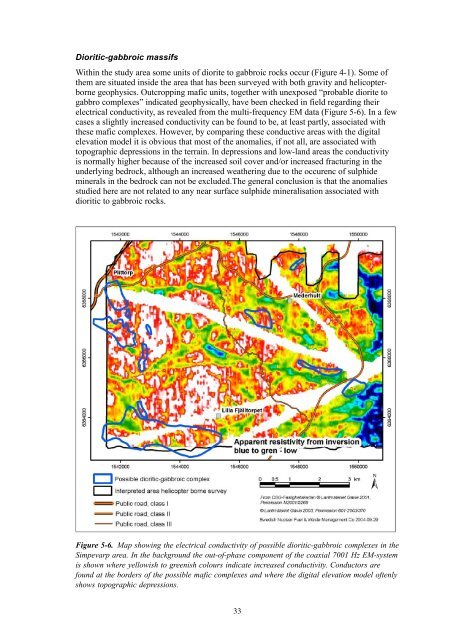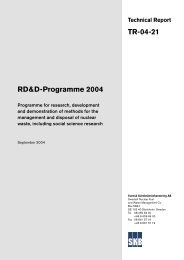Read/Download - SKB
Read/Download - SKB
Read/Download - SKB
You also want an ePaper? Increase the reach of your titles
YUMPU automatically turns print PDFs into web optimized ePapers that Google loves.
Dioritic-gabbroic massifs<br />
Within the study area some units of diorite to gabbroic rocks occur (Figure 4-1). Some of<br />
them are situated inside the area that has been surveyed with both gravity and helicopterborne<br />
geophysics. Outcropping mafic units, together with unexposed “probable diorite to<br />
gabbro complexes” indicated geophysically, have been checked in field regarding their<br />
electrical conductivity, as revealed from the multi-frequency EM data (Figure 5-6). In a few<br />
cases a slightly increased conductivity can be found to be, at least partly, associated with<br />
these mafic complexes. However, by comparing these conductive areas with the digital<br />
elevation model it is obvious that most of the anomalies, if not all, are associated with<br />
topographic depressions in the terrain. In depressions and low-land areas the conductivity<br />
is normally higher because of the increased soil cover and/or increased fracturing in the<br />
underlying bedrock, although an increased weathering due to the occurenc of sulphide<br />
minerals in the bedrock can not be excluded.The general conclusion is that the anomalies<br />
studied here are not related to any near surface sulphide mineralisation associated with<br />
dioritic to gabbroic rocks.<br />
Figure 5-6. Map showing the electrical conductivity of possible dioritic-gabbroic complexes in the<br />
Simpevarp area. In the background the out-of-phase component of the coaxial 7001 Hz EM-system<br />
is shown where yellowish to greenish colours indicate increased conductivity. Conductors are<br />
found at the borders of the possible mafic complexes and where the digital elevation model oftenly<br />
shows topographic depressions.<br />
33
















